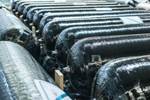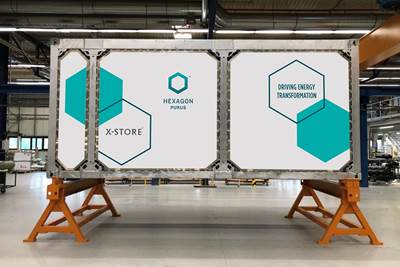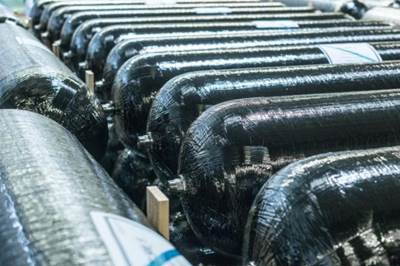Natural gas and hydrogen: A renewed opportunity?
Compressed natural gas (CNG) has been steadily gaining ground, and is proving to be a promising market for composites transportation.

Photo Credit: Getty Images
In early August, a weekly newsletter dedicated to the advancement of natural gas and — to a lesser extent — hydrogen vehicles in the U.S., started showing up in my inbox. I’m not sure what specifically got me on the distribution list, but it offered a chance to revisit this promising market for composites transportation. One specific article mentioned how Anheuser-Busch is converting 180 trucks, or 30% of its dedicated fleet, to run on renewable compressed natural gas (CNG), complementing 160 trucks converted to CNG in 2014 and 2015.
The use of CNG in urban bus systems is widespread, but the use in long-range trucking is still relatively modest, which is what attracted me to the story (the mention of beer might also have been a factor). The conversions, happening in 2020, will be provided by Agility Fuel Systems (see CW tour here), a business unit of Hexagon Composites (Alesund, Norway). The brewer estimates the combined CNG fleet will drive 8.5 million miles (13.7 million kilometers) in 2021, reducing emissions by more than 70% compared to conventional diesel. Further, the large CNG tanks will be fabricated from carbon fiber filament wound over a thermoplastic liner. These Type IV tanks are significantly lighter than steel or aluminum tanks, or metal-lined composite tanks, but the weight savings comes at a premium price.
I first developed an interest in carbon fiber overwrapped CNG tanks almost 30 years ago, during the early development of the technology. I was promoting the use of prepreg roving (towpreg) to replace wet winding, a practice some companies have since adopted. At the time, CNG was mainly targeted for passenger vehicles and light trucks. The high cost compared to steel, and problems with how to fit enough cylinders into the vehicle to provide the desired range, severely limited market penetration, at least in the U.S. In some countries, including Italy and Brazil early on, penetration rates were much higher, especially in fleet vehicles and taxis.
By the late 1990s, considerable investments were made in proton exchange membrane (PEM) fuel cell technologies, promoting clean hydrogen as an emissions-free fuel source. As I wrote in June 2017, fuel cells were faced with numerous technical problems, and the much higher pressures required for compressed hydrogen storage drove the cost of composite tanks even higher. While there remains strong interest in hydrogen and fuel cells, mass adoption has not yet occurred.
Since the beginning of this century, most efforts to change automotive powertrains have focused on battery technology, first through hybrids and — more recently — with full battery electric platforms, driven by increased power density and rapid cost reduction. This has pushed interest in CNG and fuel cells to the background, while OEMs have announced large commitments to battery electric model developments.
In this background, quietly, and to a large extent, CNG has been gaining ground, first in urban buses, and then in local fleets like garbage trucks and UPS delivery vehicles. For example, Hexagon has led the development of large tube trailers for transporting natural gas, all based on Type IV carbon fiber tanks. Natural gas produces approximately 30% fewer greenhouse gases for light vehicles and around 23% for heavy duty vehicles like the beer trucks mentioned above. Using renewable natural gas, or biomethane, yields up to a 84% reduction, per the U.S. Department of Energy (DOE). Controlled pyrolysis of polymers and composites can also be a source of “green” methane, improving the circular economy of composites.
A study conducted by IACMI and Strategic Analysis (Arlington, Virg., U.S.) in 2016 showed CNG tank costs are driven by two factors — carbon fiber costs and the amount of carbon fiber used, the latter influenced by coefficient of variation and the safety factor applied. Capital costs and resin price play minor roles in tank costs for CNG and hydrogen. To this end, in July 2020, DOE’s Hydrogen and Fuel Cell Technologies Office announced funding for four projects to reduce the cost of high tensile strength carbon fiber and optimize tank design to reduce the mass of carbon fiber needed. In the study , a combination of 25% reduction in fiber cost and 25% reduction in fiber/resin mass yields a 38% reduction in costs for CNG tanks of the size used on large trucks. The impact on hydrogen tank costs is even greater, clearing a big hurdle for fuel cell economics.
While these initiatives won’t slow down the momentum of battery electric vehicles, they do expand the opportunities for “greener” transportation in many forms, and expanded opportunities for composites, as well.
Related Content
Materials & Processes: Resin matrices for composites
The matrix binds the fiber reinforcement, gives the composite component its shape and determines its surface quality. A composite matrix may be a polymer, ceramic, metal or carbon. Here’s a guide to selection.
Read MoreInfinite Composites: Type V tanks for space, hydrogen, automotive and more
After a decade of proving its linerless, weight-saving composite tanks with NASA and more than 30 aerospace companies, this CryoSphere pioneer is scaling for growth in commercial space and sustainable transportation on Earth.
Read MoreProtecting EV motors more efficiently
Motors for electric vehicles are expected to benefit from Trelleborg’s thermoplastic composite rotor sleeve design, which advances materials and processes to produce a lightweight, energy-efficient component.
Read MoreASCEND program update: Designing next-gen, high-rate auto and aerospace composites
GKN Aerospace, McLaren Automotive and U.K.-based partners share goals and progress aiming at high-rate, Industry 4.0-enabled, sustainable materials and processes.
Read MoreRead Next
Looking for opportunity in a pandemic crisis
How do we determine our next steps in the composites industry amidst a pandemic? Dale Brosius ponders opportunities, risks and changes.
Read MoreHexagon Purus receives contract to provide hydrogen transport modules in U.S.
The all-composite 20-foot modules can carry about 600 kilograms of hydrogen and are due for delivery in the third quarter of 2021.
Read MoreHexagon Purus to produce high-performance composite pressure vessels
The subsidary of Hexagon Composites has been awarded a contract to design, develop, qualify and produce for a new major aerospace company.
Read More













.jpg;maxWidth=300;quality=90)












